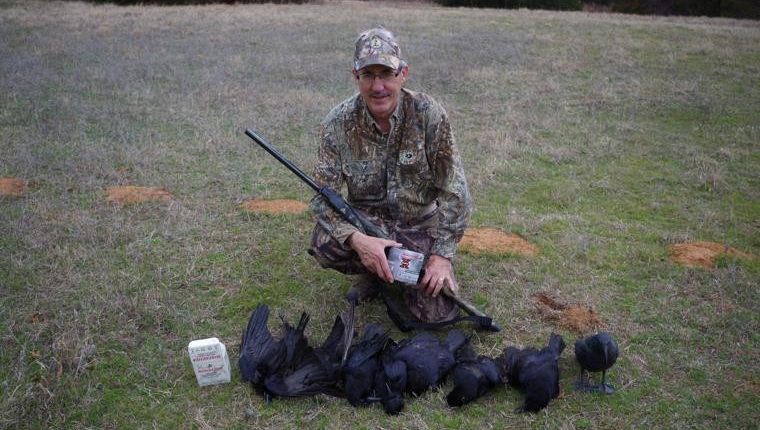To me, crows are the smartest birds in the world. As a kid, I never could outsmart them. I had a hand call but didn’t really know what I was doing. Years later, I finally learned the system. Like I said, crows are smart. But if you learn to call properly, you can smoke them.
With all of the recent crow problems in Nampa, I thought this might be a timely article. In fact, you may have seen me lately standing in front of the local grocery store holding the sign “WILL SHOOT CROWS FOR AMMO.”
Here’s how I like to hunt crows. Hide behind a super thick clump of cedars. You don’t want them to be able to see you until they’re within 20 yards or less. If they see you, they’re going to scatter.
You want to only have an opening above you. Being this well concealed makes it tough to always get a shot but if you’re exposed, they spook. So in the perfect set-up you’ll only have a hole above you. If you don’t have a perfect set-up, at least sit back in the shadows.
It’s best to be in a short clump of trees. If the trees are too tall, when they fly in skimming over the trees, they’ll almost be out of range even if they’re straight over the top of you.
You’ll also want to be camouflaged. Especially your hands and face. I wear a net over my face and at least some green army gloves. They can see your bare face if it’s not hidden and your hands are the source of most of your movement.
Like I said, I’ve used a hand call a lot, but an electronic call is by far the best. With a hand call, there’s only one of you; my electronic call sounds like there’s a whole Army of them swarming something.
I place the call about 20 yards from me in a clump of brush. I like to start off with a hawk whistle or an owl hooting. Then go to a crow/owl/hawk fight and then into your crows calling. Many times, they’ll be cawing when they come in, but a lot of times they’ll come in silently.
I also like to use a MOJO Crow decoy with the spinner wings. It comes with a 3- or 4-foot stake but it’s better to hang it up higher, so they see it better. It has a hook on it so you can tie up on a branch.
As long as they don’t see you and you don’t miss them, they’ll keep coming in. And if you happen to wound one, they’ll really come in.
So where should you set up? I don’t want to state the obvious but wherever you’re seeing crows. Find some good brush, set up and call. If you park and hear some off in the distance, you’re more than likely to have them zip right over.
So how far should you move between set-ups? I had one 50-acre spot and I did two or three set-ups on it. You can get on the north side of the place and point your speakers north and then go to the south side and point your speakers south to cover new turf.
What do you use for a gun and shells? I like my Mossberg 12-gauge semi-automatic. Crows aren’t exceptionally hard to kill and your shots will be semi close so I used Aquila low-base 6-shot.
I favor electronic calls, but how many times have you had a malfunction? Or your batteries died? So I carry a Quaker Boy hand call as a backup. Plus, it’s easy to throw one in your pocket if you’re out doing some kind of other hunting in case you run across some crows.
It seems like every time right at daylight when I’m calling varmints, crows come in. I never shoot them because I don’t want to booger up my setup, but obviously calling with a varmint call at daylight works.
So if you want to enjoy a little shooting in the off season and at the same time help the wildlife environment, grab your shotgun and go blast a few crows. They are not good neighbors. They’re death on ground birds (quail, chukars, grouse etc.). They eat their eggs.
And for the life of me I can’t figure out why Idaho protects ravens. There sure isn’t a shortage of them and they’re really bad neighbors! If we’re so worried about sage-grouse, why don’t we manage ravens? Go down in the Owyhees and look around. There’s a raven every 100 yards. It’s a miracle that one sage-grouse nest even survives.
Tom Claycomb lives in Idaho and has outdoors columns in newspapers in Alaska, Idaho, Utah, Nevada, Colorado and Louisiana. He also writes for various outdoors magazines and teaches outdoors seminars at stores like Cabela’s, Sportsman’s Warehouse and Bass Pro Shop.
